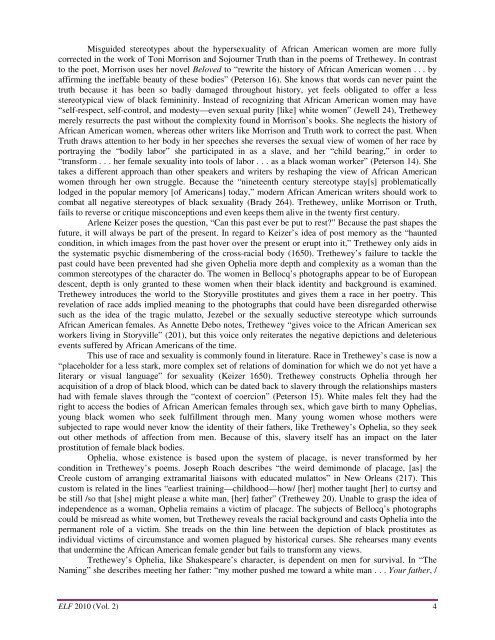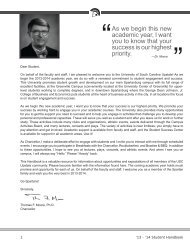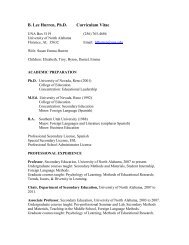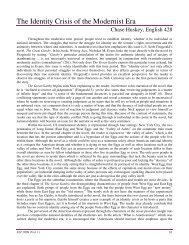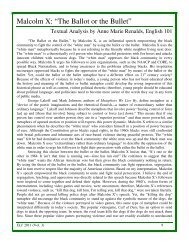Is a Picture Really Worth a Thousand Words? - University of South ...
Is a Picture Really Worth a Thousand Words? - University of South ...
Is a Picture Really Worth a Thousand Words? - University of South ...
You also want an ePaper? Increase the reach of your titles
YUMPU automatically turns print PDFs into web optimized ePapers that Google loves.
Misguided stereotypes about the hypersexuality <strong>of</strong> African American women are more fullycorrected in the work <strong>of</strong> Toni Morrison and Sojourner Truth than in the poems <strong>of</strong> Trethewey. In contrastto the poet, Morrison uses her novel Beloved to “rewrite the history <strong>of</strong> African American women . . . byaffirming the ineffable beauty <strong>of</strong> these bodies” (Peterson 16). She knows that words can never paint thetruth because it has been so badly damaged throughout history, yet feels obligated to <strong>of</strong>fer a lessstereotypical view <strong>of</strong> black femininity. Instead <strong>of</strong> recognizing that African American women may have“self-respect, self-control, and modesty—even sexual purity [like] white women” (Jewell 24), Tretheweymerely resurrects the past without the complexity found in Morrison’s books. She neglects the history <strong>of</strong>African American women, whereas other writers like Morrison and Truth work to correct the past. WhenTruth draws attention to her body in her speeches she reverses the sexual view <strong>of</strong> women <strong>of</strong> her race byportraying the “bodily labor” she participated in as a slave, and her “child bearing,” in order to“transform . . . her female sexuality into tools <strong>of</strong> labor . . . as a black woman worker” (Peterson 14). Shetakes a different approach than other speakers and writers by reshaping the view <strong>of</strong> African Americanwomen through her own struggle. Because the “nineteenth century stereotype stay[s] problematicallylodged in the popular memory [<strong>of</strong> Americans] today,” modern African American writers should work tocombat all negative stereotypes <strong>of</strong> black sexuality (Brady 264). Trethewey, unlike Morrison or Truth,fails to reverse or critique misconceptions and even keeps them alive in the twenty first century.Arlene Keizer poses the question, “Can this past ever be put to rest?” Because the past shapes thefuture, it will always be part <strong>of</strong> the present. In regard to Keizer’s idea <strong>of</strong> post memory as the “hauntedcondition, in which images from the past hover over the present or erupt into it,” Trethewey only aids inthe systematic psychic dismembering <strong>of</strong> the cross-racial body (1650). Trethewey’s failure to tackle thepast could have been prevented had she given Ophelia more depth and complexity as a woman than thecommon stereotypes <strong>of</strong> the character do. The women in Bellocq’s photographs appear to be <strong>of</strong> Europeandescent, depth is only granted to these women when their black identity and background is examined.Trethewey introduces the world to the Storyville prostitutes and gives them a race in her poetry. Thisrevelation <strong>of</strong> race adds implied meaning to the photographs that could have been disregarded otherwisesuch as the idea <strong>of</strong> the tragic mulatto, Jezebel or the sexually seductive stereotype which surroundsAfrican American females. As Annette Debo notes, Trethewey “gives voice to the African American sexworkers living in Storyville” (201), but this voice only reiterates the negative depictions and deleteriousevents suffered by African Americans <strong>of</strong> the time.This use <strong>of</strong> race and sexuality is commonly found in literature. Race in Trethewey’s case is now a“placeholder for a less stark, more complex set <strong>of</strong> relations <strong>of</strong> domination for which we do not yet have aliterary or visual language” for sexuality (Keizer 1650). Trethewey constructs Ophelia through heracquisition <strong>of</strong> a drop <strong>of</strong> black blood, which can be dated back to slavery through the relationships mastershad with female slaves through the “context <strong>of</strong> coercion” (Peterson 15). White males felt they had theright to access the bodies <strong>of</strong> African American females through sex, which gave birth to many Ophelias,young black women who seek fulfillment through men. Many young women whose mothers weresubjected to rape would never know the identity <strong>of</strong> their fathers, like Trethewey’s Ophelia, so they seekout other methods <strong>of</strong> affection from men. Because <strong>of</strong> this, slavery itself has an impact on the laterprostitution <strong>of</strong> female black bodies.Ophelia, whose existence is based upon the system <strong>of</strong> placage, is never transformed by hercondition in Trethewey’s poems. Joseph Roach describes “the weird demimonde <strong>of</strong> placage, [as] theCreole custom <strong>of</strong> arranging extramarital liaisons with educated mulattos” in New Orleans (217). Thiscustom is related in the lines “earliest training—childhood—how/ [her] mother taught [her] to curtsy andbe still /so that [she] might please a white man, [her] father” (Trethewey 20). Unable to grasp the idea <strong>of</strong>independence as a woman, Ophelia remains a victim <strong>of</strong> placage. The subjects <strong>of</strong> Bellocq’s photographscould be misread as white women, but Trethewey reveals the racial background and casts Ophelia into thepermanent role <strong>of</strong> a victim. She treads on the thin line between the depiction <strong>of</strong> black prostitutes asindividual victims <strong>of</strong> circumstance and women plagued by historical curses. She rehearses many eventsthat undermine the African American female gender but fails to transform any views.Trethewey’s Ophelia, like Shakespeare’s character, is dependent on men for survival. In “TheNaming” she describes meeting her father: “my mother pushed me toward a white man . . . Your father, /ELF 2010 (Vol. 2) 4


